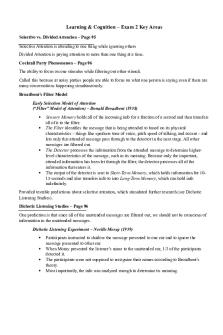Genetics Vocab Exam 2 - Lecture notes 7-13 PDF

| Title | Genetics Vocab Exam 2 - Lecture notes 7-13 |
|---|---|
| Course | Genetics |
| Institution | University of Michigan |
| Pages | 8 |
| File Size | 192.3 KB |
| File Type | |
| Total Downloads | 23 |
| Total Views | 158 |
Summary
Study notes for Bio 305 Exam 2; February 2018; Professor Baucom...
Description
Genetics Vocab Exam 2 Lecture 8: Bacterial Genetics Auxotroph: strain that requires extra nutrient that normal strain does not Prototroph: same nutritional requirements as parent(s) – Lederberg + tatum expt Conjugation- bacterial sex – transfer of plasmids (or chrom genes, less common) Episome- plasmid that can be integrated into the genome by recombination F+ (donor) – “male” – contain F plasmid and can donate genetic material -often donated – F- become F+ F- (recipient) - “female” - lack F plasmid, cannot donate genetic material F’ plasmid (F plasmid) – F plasmid accidentally picked up bacterial DNA when exits chrom. -F’ plasmid contains F plasmid + extra chrom. DNA picked up when leaving Fertility factor (F)- plasmid carried+ transmitted among bacteria cells- not part of chrom genome -codes for pili, which contact other cell + draw it in closer Hfr (high frequency of recombination)- derivitive of F+ ; when F incorporated into genome -F becomes incorporated into host genome by crossing over/recombination -produces 1000x the recombinants of normal F+ strain - F- rarely get converted to F+ or HFR at far end of linear chrom. (opposite origin) Mating types- similar to male/female sexes- only matings between opposite types offspring In E. coli, mating types are controlled by F plasmid or fertility factor -conjugation in Leaderberg/Tatum expt Merodiploid- cells w/ plasmids w/ chrom. DNA that complement genes in their DNA Plasmid- small, circular pieces of DNA in bacterial cells Rolling circle replicaitonTransformation- the process of introducing non-native DNA into a bacterial cell -common in some bacteria, rare in E. coli Transduction- transfer of DNA between bacteria via part of virus’s genome Unidirectional inheritance- only donor bacteria (F+) can transfer DNA to F- (not other way) -not common
“in conjugation, DNA is transferred from one living cell to another through close contact, whereas in transformation, isolated pieces of external DNA are taken up by a cell through the cell wall and plasma membrane”.
Griffiths, Anthony J. F.; Wessler, Susan R.; Carroll, Sean B.; Doebley, John. An Introduction to Genetic Analysis (Page 191). W. H. Freeman. Kindle Edition. Lecture 9: Viral genetics Bacteriophage
Complementation test- can determine if 2 independent mutants w/ similar recessive phenotypes are caused by mutations in same gene or different -in sexual diploid species, comp. test = cross 2 true-breeding mutants w/ sim. Phen. -if mut. In same gene, should write as (a1/a1 x a2/a2) -F1 = a1/a2 ; offspring show same mutant pheotype as parents -if diff. genes, cross should be (a1/a1 * +/+ x +/+ * a2/a2) -F1: (a1/+ * +/a2) ; show wild-type phenotype -when wild-type pheotype produced, strains “rescue” or “complement” e.o. Contransduction- movement of 2 genes by same virus -how often 2 genes packaged together can help map host genome Deletion mapping Dropout plate- missing 1 or more components of complete media Transduction Generalized transduction- when virus shatters host genome into pieces during lytic cycle -during assembly, can package host DNA instead of viral (1/1,000,000) -host DNA always single, continuous piece -can infect other host cells + insert DNA from former host Spcialized transduction- when DNA from same region of genome always transduced -can “accidentally” take neighboring regions of DNA when exits host genome -lambda phage exhibits specialized trans. Intragenic recombination- recomb within a gene - allows gene func to stay over evo time despite mutations Lysate *Multiplicity of infection (MOI) – avg # of phage particles that infect a bacteria cell in expt. -control by controlling ratio of phage: bacterial cells; Low =...
Similar Free PDFs

Genetics Vocab
- 5 Pages

Unit 2 Vocab - Lecture notes 2
- 5 Pages

Genetics Vocabulary - Vocab
- 3 Pages

Genetics - Lecture notes 8
- 7 Pages

Genetics exam 2 quizlet
- 2 Pages

Genetics EXAM 2
- 11 Pages

Unit 1 vocab - Lecture notes 2
- 2 Pages

Exam 2 - Lecture notes -
- 3 Pages

Unit 2 - Genetics - Notes
- 22 Pages

Exam 2 - Lecture notes 2
- 5 Pages

GERO exam 2 vocab - Outline
- 3 Pages
Popular Institutions
- Tinajero National High School - Annex
- Politeknik Caltex Riau
- Yokohama City University
- SGT University
- University of Al-Qadisiyah
- Divine Word College of Vigan
- Techniek College Rotterdam
- Universidade de Santiago
- Universiti Teknologi MARA Cawangan Johor Kampus Pasir Gudang
- Poltekkes Kemenkes Yogyakarta
- Baguio City National High School
- Colegio san marcos
- preparatoria uno
- Centro de Bachillerato Tecnológico Industrial y de Servicios No. 107
- Dalian Maritime University
- Quang Trung Secondary School
- Colegio Tecnológico en Informática
- Corporación Regional de Educación Superior
- Grupo CEDVA
- Dar Al Uloom University
- Centro de Estudios Preuniversitarios de la Universidad Nacional de Ingeniería
- 上智大学
- Aakash International School, Nuna Majara
- San Felipe Neri Catholic School
- Kang Chiao International School - New Taipei City
- Misamis Occidental National High School
- Institución Educativa Escuela Normal Juan Ladrilleros
- Kolehiyo ng Pantukan
- Batanes State College
- Instituto Continental
- Sekolah Menengah Kejuruan Kesehatan Kaltara (Tarakan)
- Colegio de La Inmaculada Concepcion - Cebu




